I prefer not to examine children. Sound familiar? How about when you walk in the exam room and theres a child in the chair dissecting your ophthalmoscope and a screaming baby on mommys lap? Good grief, its a nightmare. I always swore that the last thing I wanted to do was examine children for a living.
But some 27 years into my optometric odyssey, lo and behold, theres an opportunity in my town to buyyou guessed ita pediatric eye care practice. Literally overnight I was transformed into a pediatric optometrist. Whats even more amazing is that since day one, I have not regretted it for a minute!
Photo credits: Michael Melisky
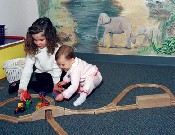
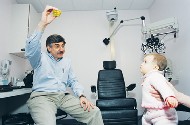
Whether you start your own pediatric practice or examine children as part of your general optometric practice, I feel that as optometrists, we are best suited for the care of childrens eye conditions. For me, backing into a pediatric practice has been a fascinating journey. Not only that, its fun.
Getting Set Up
The Childrens Eye Center (CEC), is located at the Allied Services John Heinz Rehabilitation Center in Wilkes-Barre, Pa. It resembles a small college campus. In addition to physical and occupational therapy services, there is also a spine center, orthopedic office, MRI facility, child psychologist and in-patient facilities.
The original owner of the CEC, Brian Arthur, M.D., is an excellent, fellowship-trained pediatric ophthalmologist. Before purchasing the practice, I spent time with Dr. Arthur and accompanied him as he examined patients. I found that the majority of his patients were optometry patients. I was able to solicit the services of a local pediatric ophthalmologist for the 10% to 20% of patients who required surgery or had advanced medical conditions. He agreed to consult in my office a few days a month.
I was quite fortunate to inherit a complete pediatric set-up from Dr. Arthur. His concept was to create an environment geared towards making the child feel comfortable and relaxed. As soon as the child enters the office, he sees a large hand-painted mural of an animal scene. Theres a wooden train and track set, a table with Lego blocks, and a colored bead maze on the wall. When you walk into the waiting room, youll see the children happily at play; a scene of controlled chaos.
There are three fully-equipped exam rooms with phoroptor, keratometer, slit lamp and hand instruments. I also have an autorefractor, a hand-held slit lamp and a Tono-pen for tonometry. A chart with a picture slide is a necessity, as are a Stereo Fly, Worth 4-Dot, loose lenses and prisms. Its also helpful to have some toy figures around as fixation targets, and a squeaky toy is useful in getting a younger childs attention. The most important part of the exam room is the distance fixation targets. One that I have in my office is a rabbit blowing a whistle and playing the cymbals. In the cabinet is a VCR I use to show the kids an assortment of video cartoons. (My favorite is Toy Story).
As far as other supplies go, its a good idea to have an assortment of eye patches on hand. We use a hypoallergenic, stick-on patch. Weve also found a manufacturer that makes a felt patch, which wraps around one of the childs lenses and has a child-oriented picture on it.
Designing the Dispensary
The Dreaded Exam
Your dispensary should be quite juvenile. We have brand-name frames designed for kids. (Can you imagine a talking sponge?) But we also have a nice assortment of generic frames that we provide at a reduced, complete pair price with polycarbonate lenses and a warranty. We try to do all we can to make the glasses attractive and affordable, especially for families who may
be financially strapped. But, theres no way Id let any child walk out of my office with an unflattering frame.
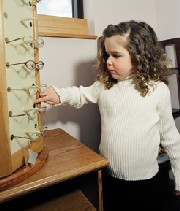
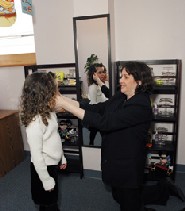
We also have special frames for infants and toddlers. They come in small eye sizes and have comfort cables. Eyeglass straps are also available in a variety of colors.
In addition, never underestimate the value of a good case. I have found a few specialty companies with some really cute and clever childrens eyeglass cases. Theres a whole range of cases from slide-in camouflages to little girls purses. Ive found that for a kid, a vertical click-topped case is infinitely more important and fascinating than the glasses themselves.
I usually dress casually to try not to give the child acute white-coat neurosis. Parents are always encouraged to join us in the exam room. I generally escort the child into the room and let him roam around before having him sit in the chair. I make a point of introducing myself to a new patient and shake his hand. I always try to make eye contact with the child and engage him in a conversation. While chatting with him, I sneak in questions about his eyes and then follow up with more direct questions to the parent.
While this talking and roaming is going on, I observe the child functioning in a visually interesting environment. I have little toys and objects strategically placed around the room and at some point Ill show him a little toy that I am holding. This gives me an opportunity to do motilities, a cover test and fixation. I test gross hand-eye coordination while rewarding junior with the toy.
He can now hop up into the chair or, if hes still a little suspicious, sit on Moms lap. At this point, try to work fast. Children, even if theyre interested, tend to get bored quickly. The Stereo Fly comes first, followed by the Worth 4-Dot, a look through the binoculars to see Toy Story, a little scoping action and a quick undilated look at the fundus.
Now its time to destroy the trust Ive builtyou guessed itdrops! The acid tinge of good old Cyclogyl will totally kill the confidence you so meticulously tried to develop. I try to avoid using it if I can, especially on follow-up exams, but often, you really have no choiceespecially with first-time patients. There are tricks for dropping them, but when all else fails, I prescribe it and have Mom be the bad guy and drop him for a return visit.
When the exam is over I explain the results of the exam to the child, shake his hand and send my new best friend (hopefully) on his way.
What to Expect
In the past, I was mostly involved with geriatric patients. And, let me tell you, there isnt much macular degeneration among children. Now, I see mostly accommodative esotropia, exotropia and strange refractive errors. But the hallmark of pediatric practice is the diagnosis and treatment of amblyopia. These children have to be diagnosed and treated at an early age. The AOAs push to examine children by age 1 and to mandate eye exams for schoolchildren is long overdue. In fact, Im amazed that pediatric medicine doesnt require it.
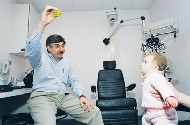
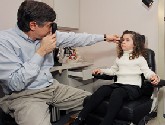
In addition to refractive problems, children occasionally present with a number of systemic and non-refractive ophthalmic conditions. In children with juvenile rheumatoid arthritis, check for iritis. In neurofibromatoses, be on the lookout for Lisch nodules (iris tumors). Nystagmus, which is usually congenital, presents frequently. Nasolacrimal duct obstruction also is very common.
Watch children with congenital cataracts carefully and regularly. Suspect congenital cataracts in patients with corneal diameters greater than 12mm. With premature babies, retinopathy of prematurity (ROP) is always a concern, but a retinologist is usually called in before the optometrist sees the child.
Its Not All Fun and Games
The biggest challenge Ive found in running the Childrens Eye Center is gaining the acceptance of the public at large and of local pediatricians. Many people will insist on seeing only an ophthalmologist and will travel hours to see one. The pediatricians are the biggest challenge and your primary source of referrals. I have found some who are thrilled to send me patients while others, quite frankly, despise me. Nevertheless, I try to stop by their offices at regular intervals and introduce myself or just say hello and chat if they have the time. A follow-up letter thanking them for taking the time doesnt hurt either.
Its also important to get to know the pediatricians staff members, especially the person in charge of referrals. My office administrator, Lyn, has taken the initiative to connect with these staff members. Her main weapon is to stop by with the standard complimentary box of doughnuts. (Shes so sharp, she knows everybodys favorite flavor!)
Obviously, it is extremely important to communicate the results of your exam to the pediatrician by letter. The letter should be short and concise and include the diagnosis and treatment plan, stated clearly and simply. I also believe that a colorful logo and clearly defined letterhead with excellent quality paper creates the appearance of competence and professionalism. The logo and letterhead should be consistent throughout all the different forms of communication. The letter should always be polite and express your appreciation for the confidence the doctor has placed in you in putting their patients eye care in your hands.
Using the same logo, send regular announcements and information to the local mass media. You are doing your community a tremendous service by informing them that there is an eye-care center totally dedicated to children. Ive found a nice-sized ad in the local newspaper that runs a few times a week, four or five times a year is adequate for my practice. As a professional, your marketing should reflect your professionalism.
The majority of pediatric disorders are best treated by O.D.s because children need the time and attention we can give them in the exam room. The AOAs InfantSEE program will help our profession and the public recognize how important childrens eye care is. We should position ourselves as the primary providers of these services.
Dr. Frank is the owner of the Childrens Eye Center in Wilkes-Barre, Pa. He is also an associate of Northeastern Eye Institute in Scranton, Pa.

